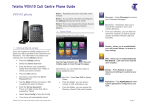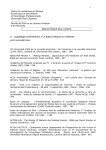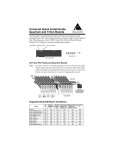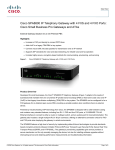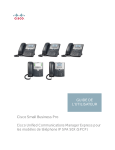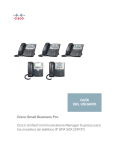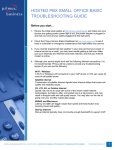Download LAN Planning Guide - XO Communications
Transcript
LAN Planning Guide LAST UPDATED: 1 May 2013 LAN Planning Guide XO Hosted PBX Document version: 1.05 Issue date: 1 May 2013 © Copyright 5/1/2013. XO Communications, LLC. All rights reserved. XO, the XO design logo, and all related marks are trademarks of XO Communications, LLC. All other trademarks are property of their respective owners. LAN Planning Guide LAST UPDATED: 1 May 2013 Table of Contents Table of Contents..................................................................................................................................................................... i About this Document............................................................................................................................................................... 1 Introduction: Components of XO Hosted PBX ......................................................................................................................... 1 LAN Fundamentals .................................................................................................................................................................. 2 Cabling and Power ............................................................................................................................................................... 2 Ethernet switching .................................................................................................................................................................. 2 Quality of Service Settings ...................................................................................................................................................... 3 Network Discovery and Configuration Services ...................................................................................................................... 3 DHCP – Dynamic Host Configuration Protocol ..................................................................................................................... 3 DNS – Domain Name System ................................................................................................................................................ 4 WAN access router and connection ........................................................................................................................................ 4 Customer-provided broadband (“BYOB”)............................................................................................................................ 4 Other LAN components ........................................................................................................................................................... 5 Firewalls .............................................................................................................................................................................. 5 Application Layer Gateway ................................................................................................................................................. 5 Network Address Translation .............................................................................................................................................. 6 Network capacity .................................................................................................................................................................... 6 WAN Bandwidth ................................................................................................................................................................... 6 LAN Bandwidth .................................................................................................................................................................... 7 Appendix 1 – LAN Topologies .................................................................................................................................................. 8 Revision History ..................................................................................................................................................................... 11 LAN Planning Guide: LAN Planning Guide © Copyright 5/1/2013. XO Communications, LLC. All rights reserved. XO, the XO design logo, and all related marks are trademarks of XO Communications, LLC. All other trademarks are property of their respective owners. LAN Planning Guide LAST UPDATED: 1 May 2013 About this Document This document is the LAN Planning guide for XO Hosted PBX. It outlines how Hosted PBX uses your network and documents the requirements that must be met for you to have the very best customer experience. Following the introduction, each section of the document explains the requirements and their background. At the end of each section, the specific technical recommendations are presented in a bulleted list. If you have questions, your XO account team is always ready to assist. Introduction: Components of XO Hosted PBX XO Hosted PBX (hereafter, “XO HPBX”) is a cloud-based communications system. Practically, that means it has the following components: Phones. These reside in your premises on your users’ desks. Each phone is connected to an Ethernet switch and (optionally) powered from it. You may also use an Analog Terminal Adapters or ATA: a device that converts an old analog device like a fax machine for use with Hosted PBX. Collectively, phones and ATAs are referred to in this document as SIP devices. An Ethernet switch connects the SIP devices to each other and to the wider network at your site. Ethernet cabling connects the SIP devices to the network. An access router links the SIP devices and computers at your site to the XO communications cloud and to the public Internet. With XO Hosted PBX, this link is dedicated to you, the customer, using MPLS technology. Some switches can provide power to phones over the same wiring as carries the network connection: these are “power-over-Ethernet” or PoE switches. When PoE switches are not used, the phones are powered from standard electrical outlets. Phones can use the same switches as computers and other devices on your network, or be partitioned into a separate network, either physically or using virtual-LAN (“VLAN”) technology within the switch. The access router also provides network discovery and network configuration services, allowing the SIP devices to identify themselves and connect to the XO cloud. The Hosted PBX call control platform lives in the XO cloud and provides call routing and the connection to the global telephone network for your SIP devices. LAN Planning Guide, Page 1 © Copyright 5/1/2013. XO Communications, LLC. All rights reserved. XO, the XO design logo, and all related marks are trademarks of XO Communications, LLC. All other trademarks are property of their respective owners. LAN Planning Guide LAST UPDATED: 1 May 2013 LAN Fundamentals Cabling and Power If the network in your office is less than five years old, chances are that you already have the right kind of LAN cabling and power at your site. R001: LAN cabling must be Category 5 or higher, with RJ-45 connectors R002: There must be adequate power outlets available to power SIP devices, switches and access router. Ethernet switching In most business networks, Ethernet switches connect computers together. You will need Ethernet switches to connect your SIP devices to each other and to the network. A best practice is to use separate switches for SIP devices and keep your PC network unchanged. This gives you room for growth and is simpler to manage. But if necessary, and with care, you can run both SIP devices and computers over the same Ethernet switches. 1 If you are combining services on one switch, you must use virtual LAN or VLANs to logically divide the switch . With VLANs, the switch keeps traffic for non-SIP devices separate from SIP devices to avoid interference. This is a good technique for smaller or low-traffic sites, albeit not perfect: very heavy load on one VLAN can slow down the switch enough to impact other VLANs even though the traffic from one is not seen by the other. If you are unsure, contact your LAN administrator or XO account team for guidance. XO Hosted PBX also includes a device known as PacketSmart. PacketSmart collects diagnostic data that XO Customer Care can use in the event that you experience call quality issues. It is designed to sit between the Ethernet switch at your site and the WAN access router. You can connect the device “in-line” in this manner, or, if your Ethernet switch supports it, connected to one port on your switch that has been configured as a “monitoring” or “mirroring” port. 1 R010: You must use 100Mbit or auto-sensing 100/1000Mbit Ethernet switches for SIP devices. Hubs and 10Mbit switches are not suitable. R011: If you plan to run SIP devices on the same switch as your other network equipment, the switch must support VLANs via 802.1Q tagging. R012: Configure an unused port on your Ethernet switch to act as a monitoring port, for use by PacketSmart, if the PacketSmart is not to be connected in-line. Without VLANs or physical separation, Ethernet switches cannot reliably support more than a handful (1-5) of phones. LAN Planning Guide, Page 2 © Copyright 5/1/2013. XO Communications, LLC. All rights reserved. XO, the XO design logo, and all related marks are trademarks of XO Communications, LLC. All other trademarks are property of their respective owners. LAN Planning Guide LAST UPDATED: 1 May 2013 Quality of Service Settings Quality of Service (QoS) refers to the network’s ability to provide different priority to different applications over a network connection. For example, in Hosted PBX, you must always prioritize voice over data so that your phone conversations take precedence on the network over activities like email and web browsing (which are not time-sensitive in the way that voice conversations are). Without QoS, users will experience dropped calls, garbled or choppy audio and clipped speech. With XO Hosted PBX, each SIP device automatically marks every packet it sends as high priority using DiffServ or DSCP 2 technology . The next step is for every device in the network path beyond the sender to understand and act on those markings. Otherwise, the QoS setting will have no effect. An infamous example is the Internet. The Internet does not, and cannot, honor QoS markings. Additionally, any inbound traffic must have QoS markings. If you are using an XO MPLS circuit to connect your site to the Hosted PBX cloud, this is automatic. But if not, and given that the Internet cannot use QoS, you should at least allow all inbound SIP and RTP traffic to have higher priority than all other traffic on the LAN. R020: Every device on your LAN between SIP devices and access router must implement DSCP QoS. R021: Use strict priority DSCP markings so that packets marked with higher DSCP values to have higher priority. R022: If you are supplying your own broadband, prioritize inbound SIP and RTP traffic from the Internet higher than LAN traffic. The specific ports associated with SIP and RTP are defined in the Firewall section of this document. Network Discovery and Configuration Services DHCP – Dynamic Host Configuration Protocol Every device at your site must have a unique address (IP address) before it can participate in the network. SIP devices are no exception. With XO Hosted PBX, the devices get their address using DHCP technology. With DHCP, devices request an address and a DHCP server on the LAN assigns one to them along with other useful parameters that help the device get onto the network. If you are providing your own broadband connection at the site, you will have to provide your own DHCP server. Otherwise, if your site is using an XO-supplied access router, the latter can provide addresses to the SIP devices. Alternatively, you can use a DHCP server that you already have (for example, you might have one that allocates addresses to the PCs on your network). The exact method will vary according to how your network is laid out. See the illustrations in the Appendix to this document for examples. 2 R030: Your LAN must provide DHCP service to SIP devices, supplying IP address/ mask, default gateway and DNS server. (Custom DHCP options such as Option 66 are not required and will be ignored if set.) Differentiated Service Code Point. LAN Planning Guide, Page 3 © Copyright 5/1/2013. XO Communications, LLC. All rights reserved. XO, the XO design logo, and all related marks are trademarks of XO Communications, LLC. All other trademarks are property of their respective owners. LAN Planning Guide LAST UPDATED: 1 May 2013 DNS – Domain Name System As noted above, every device on the network has a unique IP address. The DNS service translates easy-to-remember names, such as “www.xo.com” into IP addresses. In addition, DNS can map a single name to a list of IP addresses. This functionality is useful for cases in which device redundancy is used to improve performance and/or reliability. All SIP devices require access to the DNS service. Specifically, your network must allow them to lookup names and request two types of record: an address and a service record. These records are used by the SIP devices to configure themselves, update their firmware, and place calls. Most LANs have a DNS server available, either within the LAN itself or provided by your broadband provider (including XO). R040: Devices on your LAN must be able to query for DNS A (address) and SRV (service) records. WAN access router and connection The WAN access router connects your site to the XO cloud and the Internet. Normally, XO supplies the access router as part of the private network connection offered with XO Hosted PBX. In this design, XO controls the entire connection and, as a result, can offer guaranteed QoS and privacy. At some sites, you may alternatively supply your own broadband connection and WAN access router. We call this “BYOB” – bring your own broadband. Customer-provided broadband (“BYOB”) 3 The Bring Your Own Broadband (“BYOB”) option of the XO Hosted PBX service allows a customer to connect a site to the service using a customer-provided Internet connection instead of an XO MPLS connection. XO cannot guarantee and makes no representation as to the performance of VoIP services carried over the Internet. 3 Also commonly referred to as Bring Your Own Bandwidth. LAN Planning Guide, Page 4 © Copyright 5/1/2013. XO Communications, LLC. All rights reserved. XO, the XO design logo, and all related marks are trademarks of XO Communications, LLC. All other trademarks are property of their respective owners. LAN Planning Guide LAST UPDATED: 1 May 2013 Other LAN components Firewalls A firewall is a device that protects the LAN from potentially harmful traffic. For example, firewalls can restrict the types of services users on the LAN can access or restrict users outside of the LAN from gaining access to it. If not properly configured, firewalls can impede SIP devices from using the XO Hosted PBX service by preventing them from communicating with configuration servers, call control servers, network gateways, and other SIP devices. R060: For XO HPBX service to function properly, firewalls must allow the services listed in Table 1. Service Protocol/port Description HTTP TCP/80 Communication between SIP devices and XO Hosted PBX configuration servers. Note HTTPS TCP/443 Communication between SIP devices and XO Hosted PBX configuration servers. SIP UDP/5060, TCP/5060 UDP/8933-8943, TCP/8933-8943 Communication between local and remote SIP devices including XO Hosted PBX call control platforms, network gateways, and other elements. Note [1] RTP UDP/19560-24560 Communication between local and remote SIP devices including XO Hosted PBX call control platforms, network gateways, and other elements. Note [2] NTP UDP/123 DNS UDP/53, TCP/53 Used by SIP devices to synchronize internal clocks with network time servers. Used by SIP devices to map names to IP addresses as part of service discovery. Table 1: Firewall filter rules Notes Note 1: Port 8933 is not commonly associated with SIP. In this instance, it is used to avoid encounters with Application Layer Gateway (ALG) functionality that may damage the payload of SIP packets. Note 2: Ports 19560-24560 are not commonly associated with RTP. As in the SIP case, the port range is chosen to avoid encounters with Application Layer Gateway (ALG) functionality that may damage the payload. For more information on ALGs, refer to the Application Layer Gateway section of this document. Application Layer Gateway XO Hosted PBX is a VoIP (voice-over-IP) service, which means that your voice calls are split into packets of data and transported over the network. Some older networks attempt to recognize VoIP traffic as it crosses the access router and manipulate it in an attempt to make it work more smoothly. This function is called Application Level Gatewaying or ALG. Ironically, ALG makes things worse, because modern VoIP technology no longer needs this manipulation. If you are using an XO-supplied WAN access router, you do not need to worry about ALGs. LAN Planning Guide, Page 5 © Copyright 5/1/2013. XO Communications, LLC. All rights reserved. XO, the XO design logo, and all related marks are trademarks of XO Communications, LLC. All other trademarks are property of their respective owners. LAN Planning Guide LAST UPDATED: 1 May 2013 If you are supplying your own broadband access, then all ALG functionality between the SIP device and the WAN should be turned off. Doing this eliminates the potential for the ALG to improperly translate packets and render service unusable. If you cannot disable ALG function, XO HPBX may function, although XO cannot make any guarantees. In this scenario the service will uncommon ports for SIP and RTP traffic, where uncommon means “less likely to be noticed by the ALG”. 4 Port 8933 is used instead of 5060 for SIP, and the range 19560-24560 for RTP . For assistance configuring ALG function, please contact the manufacturer of your device. There are also resources on the Internet, for example the instructions here. R070: If you are using BYOB, disable any ALG function. Network Address Translation Network Address Translation (NAT) is a common router function which allows multiple private IP addresses on a LAN to be translated to a single public IP address on the WAN. NAT hides your LAN addresses behind a single public address and allows multiple devices to access the WAN without requiring that each one have its own address on the WAN. Most business networks use NAT today. If you are using an XO-supplied WAN access router, you do not need to worry about NAT. The access router performs a technique called NAT traversal and an associated technique called Media Relay or Media Latching to ensure that both inbound and outbound calling works without exposing your LAN. If you are supplying your own broadband access, then you must configure your NAT service to permit SIP devices to make and receive calls. Your NAT service must be SIP-aware, and in particular able to establish a long-lived binding between an internal SIP device and an external IP address. Without this binding, you might be able to make calls, but not receive them, or speak, but not hear the other party. A good bind lifetime range is 30-60 seconds. R080: If you are using BYOB, configure a NAT bind-timer of between 30 and 60 seconds. Network capacity WAN Bandwidth The amount of bandwidth available will determine the amount of simultaneous voice calls and data traffic that your WAN connection will support. Remember, however, that a large amount of bandwidth does not, by itself, equate to higher call quality: without QoS, even the largest connection can fail to deliver adequate call quality. If you are using XO-supplied WAN connectivity, your XO Sales Engineer will work with you to size the most appropriate circuit for the mix of user population, load and traffic type at your site. You might, for example, require a 3Mbit circuit at a satellite office and a 10Mbit circuit at a regional HQ. If you are providing your own broadband connection, your bandwidth is determined by your (other) service provider. In this case, if properly sized and with the proper QoS settings in the router, the XO HPBX service should function properly, although XO cannot guarantee or make any representation. 4 Although not defined by any official standard, the industry norm for RTP is the range 16384-16482. LAN Planning Guide, Page 6 © Copyright 5/1/2013. XO Communications, LLC. All rights reserved. XO, the XO design logo, and all related marks are trademarks of XO Communications, LLC. All other trademarks are property of their respective owners. LAN Planning Guide LAST UPDATED: 1 May 2013 However, if undersized or if QOS is not provisioned correctly, perceived call quality will noticeably deteriorate during peak traffic times. The following information provides information and guidelines for properly sizing voice service for a given WAN bandwidth. The maximum number of simultaneous calls that can be supported must first be calculated using one of the following formulas: Max Simultaneous Calls = Available Voice Bandwidth (Kbps) / 96Kbps) Max Phones = Max Simultaneous Calls * Users per Simultaneous Call where Available Voice Bandwidth (Kbps) – is the maximum amount of Internet bandwidth allowed for voice traffic. This value is the lower of the connection’s download and upload speeds, minus an amount reserved for processing data traffic. 96Kbps – is the bandwidth required for a normal phone call (includes ATA connected devices) and Max Simultaneous Calls – is the amount of simultaneous calls that can be supported over the given bandwidth (calculated earlier). Users per Simultaneous Call – is a statistical approximation of the total number of users that can share one call path with non-blocking results. The value of 4 is recommended for average office usage. This number can vary drastically depending on the type and size of office and phone usage such as a call center or other high call volume scenario. Offices with routers provisioned to prioritize voice traffic over data traffic can process voice calls at up to 100% of total connection bandwidth without jeopardizing call quality. However, at sustained high call volumes, data traffic quality will be impacted. As a result, it is recommended that calculations for maximum calls and maximum phones be done assuming only a portion of the overall bandwidth can be used for voice traffic. LAN Bandwidth LAN bandwidth is the amount of traffic your internal network can support. This amount is determined by the throughput specification of the LAN infrastructure (switches and cabling). The amount of bandwidth available will determine the amount of simultaneous voice calls and data traffic that your LAN will support. Generally speaking, assuming your LAN meets the requirements in this document, the LAN will have adequate bandwidth to support XO Hosted PBX. However, if undersized, perceived call quality will deteriorate during peak traffic times. It is your responsibility to ensure that your LAN is sized properly to support the addition of XO Hosted PBX. LAN Planning Guide, Page 7 © Copyright 5/1/2013. XO Communications, LLC. All rights reserved. XO, the XO design logo, and all related marks are trademarks of XO Communications, LLC. All other trademarks are property of their respective owners. LAN Planning Guide LAST UPDATED: 1 May 2013 Appendix 1 – Supported LAN Topologies This section illustrates the LAN design scenarios supported by XO Hosted PBX. 1. Converged LAN with data and voice VLANs. 1 Single and/or separate cable drops. Customer-provided DHCP to PCs. XO-provided DHCP to phones. Separate DIA and MPLS handoff w/ NAT. VLAN Tag set in XO service provider web portal. DIA (Internet) Optional MPLS (Site-To-Site Data) DHCP (Customer VLAN 1) Customer Firewall/Router Untagged VLAN 1 Untagged VLAN 2 MPLS+NAT+DHCP Packetsmart 2-port Inline mode XO Router Customer PoE Switch (managed) Untagged VLAN 1 Tagged VLAN 2 IP Phone Computers Figure 1 LAN topology #1 – “Converged LAN” 2. Separate LANs dedicated to SIP devices and computers. 2 Separate cable drops. Physically separate LANs*. Customer-provided DHCP to PC’s. XO-provided DHCP to phones. Separate DIA and MPLS handoff w/ NAT. (*Security discussion required) DHCP (Customer) DIA (Internet) Optional MPLS (Site-To-Site Data) Customer Firewall/Router Customer Edge Switch Customer PoE Switch (unmanaged) MPLS+NAT+DHCP XO Router Computers Packetsmart 2-port Inline mode IP Phone Figure 2 LAN topology #2 –separate LAN LAN Planning Guide, Page 8 © Copyright 5/1/2013. XO Communications, LLC. All rights reserved. XO, the XO design logo, and all related marks are trademarks of XO Communications, LLC. All other trademarks are property of their respective owners. LAN Planning Guide LAST UPDATED: 1 May 2013 3. Flat LAN, no VLANs, only suitable for very small deployments (less than 5 phones). 3 Single or separate cable drops. Flat LAN*. Customer-provided DHCP to PC’s and Phones. (*Customer-provided routing for HPBX phones with PCs and phones in the same address space in very small deployments.) DHCP (Customer) Customer Firewall/Router DIA (Internet) Customer PoE Switch (unmanaged) MPLS XO Router Packetsmart 2-port Inline mode IP Phone Computers Figure 3 LAN Topology #3 – Flat LAN, no VLANs 4. Converged LAN with VLANs and PacketSmart on monitoring port. 4 Single and/or separate cable drops. Customer-provided DHCP, VLANs, and SPAN (Mirror) port for Packetsmart. Single handoff for DIA (Internet) and MPLS. VLAN Tag set in XO service provider web portal or customer tagging via DHCP. Optional XO Enterprise Cloud Security. Packetsmart 3-port mirror-mode SPAN (Mirror) Port XO Router XO Router Untagged VLAN 2 Customer PoE Switch (managed) DHCP DIA + MPLS Customer Firewall/Router Untagged VLAN 1 Tagged VLAN 2 IP Phone Computers Figure 4 LAN Topology #4 – converged LAN with PacketSmart on monitoring port LAN Planning Guide, Page 9 © Copyright 5/1/2013. XO Communications, LLC. All rights reserved. XO, the XO design logo, and all related marks are trademarks of XO Communications, LLC. All other trademarks are property of their respective owners. LAN Planning Guide LAST UPDATED: 1 May 2013 5. Converged LAN with XO Hosted Security 5 XO Hosted Security with XO Hosted PBX. Single and/or separate cable drops. Customer-provided DHCP to PC’s. XO-provided DHCP to phones. VLAN Tag set in XO service provider web portal. Untagged Data VLAN 1 Untagged DMZ VLAN 3 Untagged VLAN 1 Packetsmart 2-port Inline mode Customer DHCP Server (PC’s) Customer PoE Switch (managed) Untagged Voice VLAN 2 IPVPN+DHCP XO Router Untagged VLAN 3 Customer Mail Server Untagged VLAN 1 Tagged VLAN 2 IP Phone Computers Figure 5 LAN Topology #5 – Converged LAN with XO Hosted Security 6. Bring-your-Own-Broadband (“Bring-your-own-Bandwidth”) 6 Bring Your Own Bandwidth. Single or separate cable drops. Flat LAN*. Customer-provided DHCP to PC’s and Phones. (*PCs and phones in the same address space in small deployments. 15 Phones or less.) ExamiNet test required. Customer PoE Switch (unmanaged) DHCP (ISP) ISP Firewall/ Router Packetsmart 2-port Inline mode IP Phone Computers Figure 6 LAN Topology #6 - BYOB LAN Planning Guide, Page 10 © Copyright 5/1/2013. XO Communications, LLC. All rights reserved. XO, the XO design logo, and all related marks are trademarks of XO Communications, LLC. All other trademarks are property of their respective owners. LAN Planning Guide LAST UPDATED: 1 May 2013 Appendix 2 – Customer supplied phones – supported models and firmware XO Hosted PBX works with a wide range of phones from leading vendors. In most cases XO supplies the devices, but in some circumstances you may elect to supply your own. In this case, several rules apply: You may only use devices that are supported by XO Hosted PBX, currently Polycom SoundPoint IP 321, 335, 450, 550, 560, 650, 670 Polycom SoundStation IP 6000 Polycom VVX500 and 1500 Cisco SPA 502G, 504G, 508G and 509G Cisco SPA 122 and 8000. The device must be appropriate for the Hosted PBX Seat type used. For example, a Polycom 450 cannot be used with an Executive Video seat, since that model phone has no video capability. Conversely, you will not want to assign a premium phone like the Polycom 670 to a basic seat type such as Standard. The devices must run a minimum supported firmware vintage, as follows: Polycom: SIP loader v4.0 Cisco SPA phones: SIP firmware v7.4.0 Cisco SPA 122 ATA: v1.3 Cisco SPA8000 ATA: v6.1 Revision History . Date Version Author Details 7 Mar 2013 8 Mar 2013 8 Mar 2013 28 Mar 2013 1 May 2013 1.01 1.02 1.03 1.04 1.05 Gurung Gurung Gurung Gurung Gurung Derived from source documents. Updated following first internal review. Minor updates to topology 3 rules. Updated references to BYOB, for consistency. Added section on customer-supplied devices, updated supported LAN topologies to align with standard terms. LAN Planning Guide, Page 11 © Copyright 5/1/2013. XO Communications, LLC. All rights reserved. XO, the XO design logo, and all related marks are trademarks of XO Communications, LLC. All other trademarks are property of their respective owners. LAN Planning Guide LAST UPDATED: 1 May 2013 <End> LAN Planning Guide, Page 12 © Copyright 5/1/2013. XO Communications, LLC. All rights reserved. XO, the XO design logo, and all related marks are trademarks of XO Communications, LLC. All other trademarks are property of their respective owners.
















